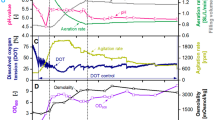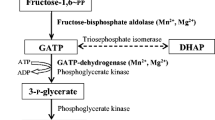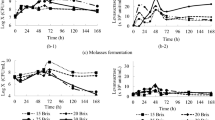Abstract
The Lactobacillus brevis subsp. lindneri CB1 fructose-negative strain utilized fructose in co-fermentation with maltose or glucose. Compared to the maltose (17 g/l) fermentation, the simultaneous fermentation of maltose (10 g/l) and fructose (7 g/l) increased cell yield (A 620from 2.6 to 3.3) and the concentrations of lactic acid and especially of acetic acid (from 2.45 g/l to 3.90 g/l), produced mannitol (1.95 g/l) and caused a decrease in the amount of ethanol (from 0.46 g/l to 0.08 g/l). The utilization of fructose depended on the continuous presence of maltose in the growth medium and the two carbohydrates were consumed in a molar ratio of about 2:1. The presence of tagatose (a fructose stereoisomer) partially inhibited fructose consumption and consequently caused a decrease of the end products of the co-metabolism. Since maltose was naturally present during sourdough fermentation, the addition of only 6 g fructose/kg wheat dough enabled the co-fermentation of maltose and fructose by L. brevis subsp. lindneri CB1. A higher titratable acidity and acetic acid concentration, and a reduced quotient of fermentation (2.7) were obtained by co-fermentation compared with normal sourdough fermentation. Some interpretations of the maltose-fructose co-fermentation are given.
Similar content being viewed by others
References
Abrams A (1960) Metabolically dependent penetration of oligosaccharides into bacterial cells and protoplasts. J Biol Chem 235:1281–1285
Axelsson LT (1993) Lactic acid bacteria: classification and physiology. In: Salminen S, Wright A von (eds) Lactic acid bacteria. Dekker, New York, p 1
Bergmeyer HU (1984) d-Mannitol. In: Bergmeyer HU, Bergmeyer J, Grassl M (eds) Methods of enzymatic analysis, 3rd edn. Weinheim, Deerfield Beach, Flo, p 271
Boos W (1974) Bacterial transport. Annu Rev Biochem 43:123–146
Cogan TM (1987) Co-metabolism of citrate and glucose by Leuconostoc ssp: effects on growth, substrates and products. J Appl Bacteriol 63:551–558
Cunha MV da, Foster MA (1992) Sugar-glycerol cofermentations in Lactobacilli: the fate of lactate. J Bacteriol 174:1013–1019
Dills SS, Apperson A, Schmidt MR, Saier MH (1980) Carbohydrate transport in bacteria. Microbiol Rev 44:385–418
Galli A, Franzetti L, Fortina MG (1988) Isolation and identification of sourdough microflora. Microbiol Alim Nutr 6:345–351
Gobbetti M, Rossi J (1991) The sourdough microorganisms: lactic acid bacteria and yeasts. In: Adria-Normandie (eds) Lactic 91, Lactic acid bacteria. Research and industrial applications in the agro-food industries, 12–13 September, Caen, Normandy, France, Region Basse Normandie, Caen, p 35
Gobbetti M, Corsetti A, Rossi J (1993) The sourdough microflora. Genetic approach for the improvement of sourdough microflora: Lactobacillus brevis subsp. lindneri CB1. In: Zamorani A, Manachini PL, Bottazzi V, Coppola S (eds) Biotechnology and molecular biology of lactic acid bacteria for the improvement of foods and feeds quality, 23–24 February, Naples, Italy, Instituto Poligrafico e Zecca dello Stato, Roma, p 192
Gobbetti M, Corsetti A, Rossi J (1994a) The sourdough microflora. Identification and clustering of lactic acid bacteria and yeasts from sourdoughs of Central Italy. Ital J Food Sci 1:85–94
Gobbetti M, Corsetti A, Rossi J (1994b) The sourdough microflora. Interaction between lactic acid bacteria and yeasts: metabolism of amino acids. Appl Microbiol Biotechnol 41:456–460
Gobbetti M, Corsetti A, Rossi J (1994c) The sourdough microflora. Interaction between lactic acid bacteria and yeasts: metabolism of carbohydrates. World J Microbiol Biotechnol 10:275–279
Gobbetti M, Corsetti A, Rossi J (1994d) The sourdough microflora. Evolution of soluble carbohydrates during the sourdough fermentation. Microbiol Alim Nutr 12:9–15
Kandler O, Weiss N (1986) Genus Lactobacillus. In: Sneath PHA, Sharpe ME, Holt JG (eds) Bergey's manual of systematic bacteriology, vol 2, Williams and Wilkins, Baltimore, p 1219
Kline L, Sugihara TF (1971) Microorganisms of San Francisco sourdough bread process. II. Isolation and characterization of undescribed bacterial species responsible for souring activity. Appl Microbiol 21:459–465
Konings WN, Otto R (1983) Energy transduction and solute transport in streptococci. Antoine Van Leeuwenhoek 49:247–257
Michels PAM, Michels JPJ, Boonstra J, Konings WN (1979) Generation of an electrochemical proton gradient in bacteria by the excretion of metabolic end products. FEMS Microbiol Lett 5:357–364
Poolman B (1993) Biochemistry and molecular biology of galactoside transport and metabolism in lactic acid bacteria. Lait 73:87–96
Quaglia G (1984) La fermentazione. In: Quaglia G (ed) Scienza e tecnologia della panificazione. Chiriotti, Pinerolo, Italy, p 295
Romano AH, Trifone JD, Brulston M (1979) Distribution of the phosphoenolpyruvate:glucose phosphotransferase system in fermentative bacteria. J Bacteriol 139:93–97
Romano AE, Brino G, Peterkofsky A, Reizer J (1987) Regulation of β-galactoside transport and accumulation in heterofermentative lactic acid bacteria. J Appl Bacteriol 169:5589–5596
Spicher G (1983) Baked Goods. In: Rehm HJ, Reed G (eds) Biotechnology, vol 5. Verlag Chemie, Weinheim, p 1
Spicher G (1987) The microflora of sourdough XXII. Communication: the Lactobacillus species of wheat sourdough. Z Lebensm Unters Forsch 184:300–303
Spicher G, Lönner C (1985) The microflora of sourdough. XXI. Communication: the Lactobacillus species of sourdough from Swedish Bakeries. Z Lebensm Unters Forsch 181:9–13
Spicher G, Nierle W (1984) The microflora of sourdough XIX. Communication: the influence of the temperature and dough yield on the proteolytic activity of lactic acid bacteria of sourdough. Z Lebensm Unters Forsch 179:36–39
Spicher G, Rabe E (1980) The sourdough microflora. XI. Communication: the influence of temperature on the production of lactate and acetate in sourdoughs, started with heterofermentative sourdough bacteria. Z Lebensm Unters Forsch 171:437–442
Spicher G, Rabe E, Sommer R, Stephan H (1981) The sourdough microflora. XIV. Communication: about the behaviour of homofermentative sourdough bacteria and yeasts in mixed culture. Z Lebensm Unters Forsch 173:291–296
Spicher G, Rabe E, Sommer R, Stephan H (1982) The sourdough microflora XV. Communication: on the behaviour of heterofermentative sourdough bacteria and yeasts in mixed culture. Z Lebensm Unters Forsch 174:222–227
Spicher G, Schröder R (1978) Die Bedeutung der “Sauerteighefen” fur die Sauerteiggärung. Getreide Mehl Brot 32:295–301
Sugihara TF, Kline L, McCready LB (1970) Nature of the San Francisco sour dough French bread process. I. Microbiological aspects. Baker's Dig 44:50–52
Talarico TL, Axelsson LT, Novonny J, Fiuzat M, Dobrogosz WJ (1990) Utilization of glycerol as a hydrogen acceptor by Lactobacillus reuteri: purification of 1,3-propanediol: NAD+ oxidoreductose. Appl Environ Microbiol 56:943–948
Tseng CP, Tsau JL, Montville TJ (1991) Bioenergetic consequences of catabolic shifts by Lactobacillus plantarum in response to shifts in environmental oxygen and pH chemostat cultures. J Bacteriol 173:4411–4416
Wilson DB (1974) The regulation and properties of the galactose transport system in Escherichia coli K12. J Biol Chem 249:553–558
Author information
Authors and Affiliations
Rights and permissions
About this article
Cite this article
Gobbetti, M., Corsetti, A. & Rossi, J. Maltose-fructose co-fermentation by Lactobacillus brevis subsp. lindneri CB1 fructose-negative strain. Appl Microbiol Biotechnol 42, 939–944 (1995). https://doi.org/10.1007/BF00191194
Received:
Revised:
Accepted:
Issue Date:
DOI: https://doi.org/10.1007/BF00191194




